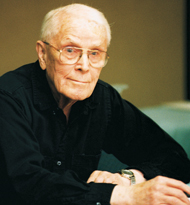A Brief History of Geriatrics
The Development of a Medical Discipline to Meet Patients’
Emerging Needs
The challenge of preparing sufficient numbers of future leaders in geriatrics is made even more difficult by the fact that geriatric medicine is a young discipline, which has not yet gained equal stature with more established specialties in many academic medical centers.
While the term “geriatrics” was first coined in 1909, geriatrics has established itself as a medical discipline in the U.S. only in the last three decades. Writing in 2004 in the journal Geriatrics and Gerontology International, William R. Hazzard, MD, states that prior to 1978, “there were no trained geriatricians; no geriatrics faculty to develop model geriatrics care programs, train geriatricians, educate medical students, residents, or practicing physicians, or conduct aging-related research. There was no recognition as a specialty by the American Board of Internal Medicine and no designated training programs for faculty development or clinical geriatrics training.”
In 1974, the National Institutes of Health established the National Institute on Aging. In 1975, the Veterans Health Administration (VA) established Geriatric Research, Education and Clinical Care Centers (GRECCs) to improve the quality of care for older veterans. In addition, a few medical centers were setting up programs (but not separate departments) in geriatrics.
 Dr. Paul Beeson
Dr. Paul Beeson Although the first fellowship in geriatric medicine was created in 1966 (at City Hospital Center, a Mount Sinai School of Medicine affiliate), a major turning point for the field of geriatrics came in 1978 when Paul B. Beeson, MD, spearheaded the first of a series of Institute of Medicine (IOM) reports highlighting the challenges facing the medical profession as the population ages. Dr. Beeson had been a professor of medicine at Oxford, where geriatrics was an established academic specialty. In the United Kingdom, geriatrics was designated as a medical specialty when the National Health Service was created after World War II. At a time when no corresponding discipline existed in the United States, all United Kingdom medical schools and hospitals had departments of geriatrics.
Divisions of geriatric medicine, usually in a department of internal medicine at most U.S. academic health centers, continue to evolve. In 1982, the first separate department of geriatrics was created at Mount Sinai School of Medicine. Today, there are six departments of geriatrics in medical schools across the country, and 105 U.S. medical schools have some kind of academic geriatric structure.
Thus, training in geriatric medicine has grown considerably in the last two decades. In addition to advanced fellowship training, geriatrics content is now present in many medical schools; in one recent survey 92 percent of family practice programs and 93 percent of internal medicine programs have some geriatric content in their curriculum. And the Hartford Foundation has encouraged early exposure to geriatrics through grants such as the Medical Student Summer Research Training in Aging program at the American Federation for Aging Research and curriculum projects at the Association of American Medical Colleges.
Dr. Beeson's 1978 IOM report, Aging and Medical Education, called for increased training in geriatrics, and it recommended that all medical schools and teaching hospitals include curricula on aging for medical students and residents. Also in 1978, the VA established two-year geriatric fellowship programs at 12 VA medical centers. The numbers of geriatric medicine fellowship programs subsequently increased, expanding from 31 programs in 1981 to 93 programs in 1986. Fellowships generally lasted two years.
In the late 1980s, geriatric fellowships grew even more as a result of several factors. Sparking the recognition of the need for more rapid growth was a second IOM study published in 1987. This report emphasized that it was necessary to develop the capacity to train academic leaders in geriatrics, and recommended establishing
“Centers of Excellence” in geriatric medicine. To explicitly support advanced fellowship training, in 1988, the John A. Hartford Foundation responded to the findings of this report by funding the first Centers of Excellence.
In 1988, the American Boards of Family Practice and Internal Medicine established a Certificate of Added Qualifications (CAQ) in geriatric medicine, which required two years of fellowship training. At the same time, the Accreditation Council for Graduate Medical Education (ACGME) accredited 62 internal medicine and 16 family practice geriatric medicine fellowship programs. In 1998, to encourage physicians to enter geriatric fellowship training programs, the two-year requirement was reduced to one year. Between 1988 and 2002, 10,207 doctors received certification in geriatric medicine.
In concert with these changes in the structure of academic geriatrics and the evolution of geriatrics fellowship programs, aging research has mushroomed over the last 30 years. The approved budget of the NIA now exceeds $1 billion. Aging research is on the agenda at other institutes within the NIH including the National Heart, Lung and Blood Institute (looking at cardiovascular disease in the elderly), the National Cancer Institute (as 63 percent of oncology patients in the U.S. are over age 65), the National Institute of Musculoskeletal Disease, the National Eye Institute, and the National Institute of Mental Health.
Yet, despite the impressive progress in elevating the field of geriatrics over the past few decades, there continues to be a critical shortage of geriatricians and geriatrically-trained primary care physicians to care for the growing number of older adults in the U.S.
“Geriatrics is still a very new field, and is still trying to compete for attention with more established disciplines like cardiology, nephrology, and others,” says Mary E. Tinetti, MD, the Gladys Phillips Crofoot Professor of Medicine and Epidemiology and Public Health, and Director of the Yale Hartford Foundation Center of Excellence in Aging, Yale University School of Medicine. “We continue to need concerted efforts to enhance the visibility, credibility, and credentials of geriatrics to become embedded in academic medical centers in order to adequately research, teach and care for older people.”
